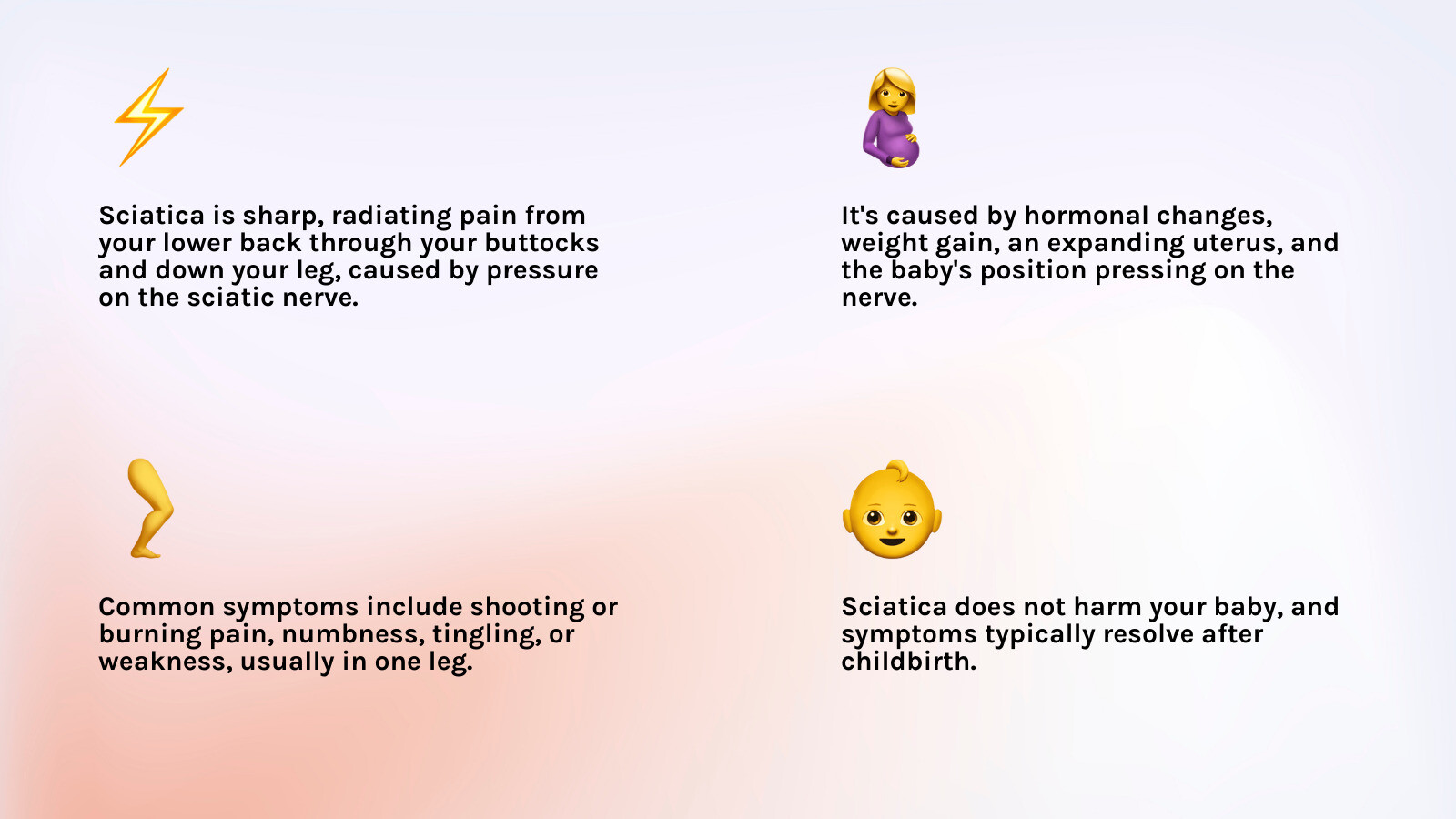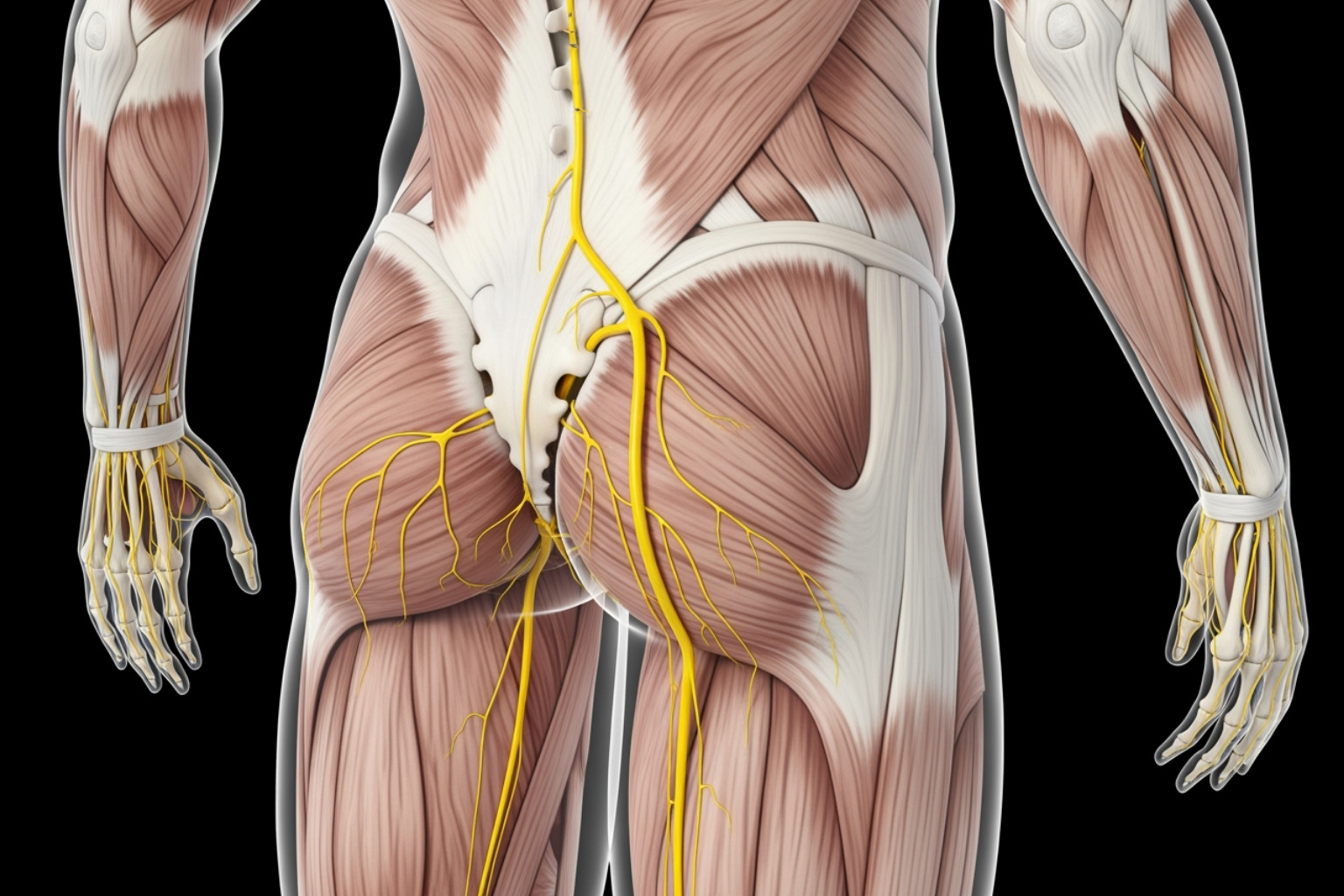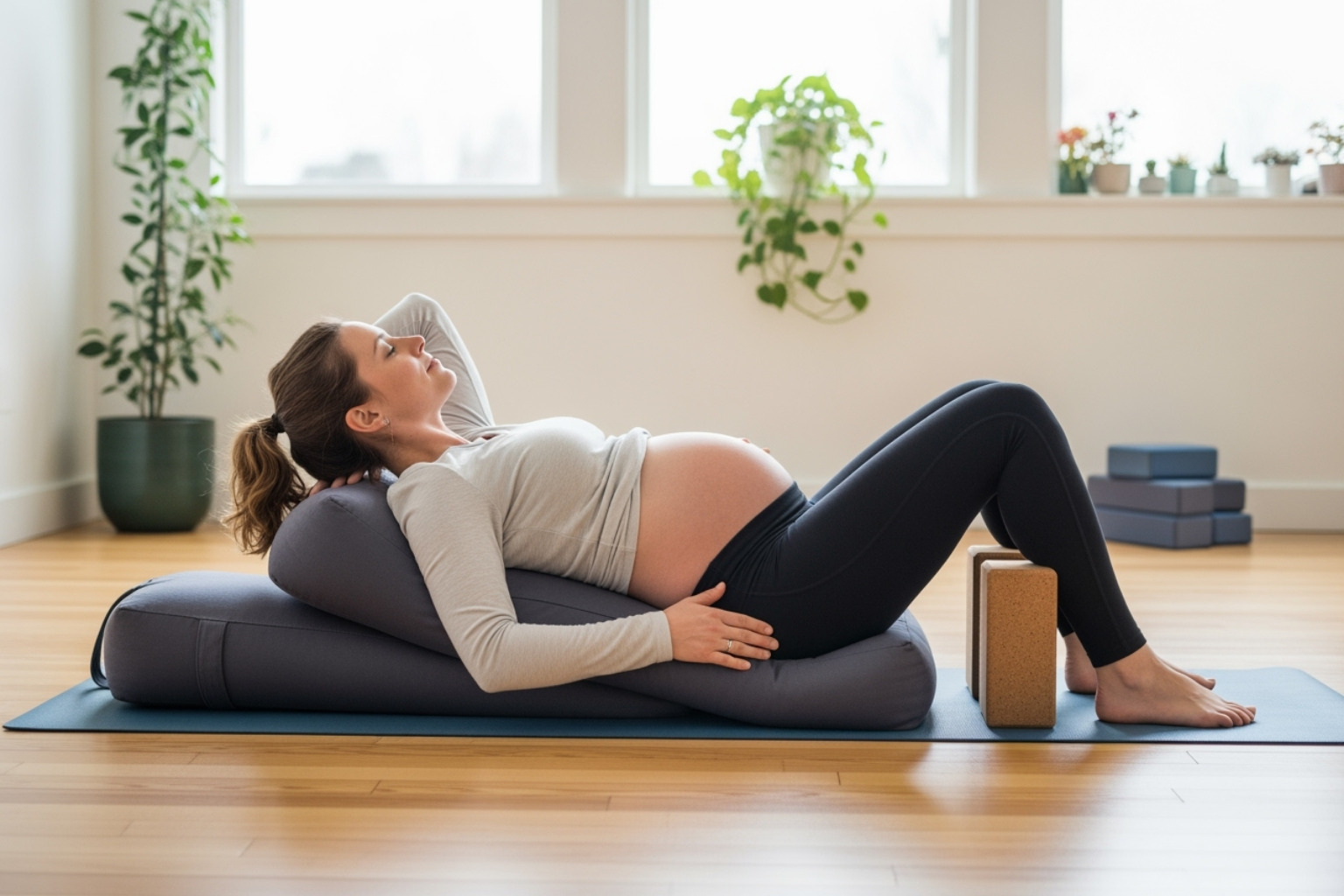Understanding Sciatica During Pregnancy: What Every Expectant Mother Should Know
Sciatica pregnancy is a common issue, with many women experiencing sciatic pain during pregnancy. While official diagnoses are low, many cases are often dismissed as general pregnancy back pain.
Quick Answer: Key Facts About Sciatica During Pregnancy
- What it is: Sharp, radiating pain from your lower back down your leg, caused by pressure on the sciatic nerve.
- Why it happens: Hormonal changes, a shifting center of gravity, and the baby's weight putting pressure on the nerve.
- Common symptoms: Shooting or burning pain, numbness, tingling, or weakness in one leg.
- When it occurs: Most commonly in the third trimester.
- Relief options: Gentle stretches, heat/cold therapy, proper posture, prenatal massage, physical therapy, and topical pain relief creams.
- Important: Sciatica does not harm your baby and usually resolves after childbirth.
The good news is that you don't have to endure this pain. At Neuropasil, we specialize in helping people manage nerve and muscle pain, including the unique challenges of sciatica during pregnancy. We understand how pain can impact this special time and are dedicated to providing fast-acting, natural topical relief.

Basic sciatica pregnancy glossary:
- pinched nerve in lower back
- what causes sciatic nerve pain
- drug free sciatica relief
Why Does Sciatica Happen During Pregnancy?
The causes of sciatica pregnancy are a combination of hormonal shifts, physical changes, and the baby's growth. Up to 80% of pregnant women experience lower back pain, and for many, this includes sciatica. Understanding the causes can help you find effective relief.
The Role of Hormones and Physical Changes
During pregnancy, your body releases a hormone called relaxin. Its job is to loosen ligaments to prepare your pelvis for childbirth. However, relaxin doesn't just target your pelvis; it affects ligaments throughout your body, including your spine.
This loosening can lead to pelvic instability and cause shifts in the spine and pelvis, altering your posture. These changes, combined with natural weight gain, fluid retention, and an expanding uterus, increase pressure on your joints and spine. Your growing belly shifts your center of gravity forward, causing your lower back to arch. This strain can compress the Sciatic Nerve.
These postural changes can also lead to piriformis syndrome. The piriformis muscle, located in the buttocks, can tighten or spasm, pressing on the sciatic nerve and causing sciatica-like pain.
How the Baby's Position Contributes
Your baby's position can also be a direct cause of pain, especially in the third trimester. As your baby grows and moves into position for birth, their head or body can rest directly on the sciatic nerve.
This direct nerve compression can cause intense, sharp pain down your leg. You might notice the pain fluctuates as your baby shifts positions. This exacerbating pain is common and typically temporary, with many women finding relief after the baby is born.
Recognizing the Signs: What Does Pregnancy Sciatica Feel Like?
Sciatica pregnancy pain is distinct from general back pain. It follows the path of the sciatic nerve, the body's largest nerve, which runs from the lower back, through the buttocks, and down the back of each leg.

Key symptoms often affect just one side of the body and include:
- Radiating Pain: The most telling sign is pain that starts in the lower back or buttock and travels down the leg, sometimes to the foot.
- Burning or Shooting Sensations: Many describe a burning sensation or sharp, shooting pains like electric shocks that can make simple movements difficult.
- Numbness and Tingling: A "pins and needles" feeling or numbness can occur anywhere along the nerve's path.
- Muscle Weakness: In some cases, you may experience muscle weakness in the affected leg or foot, making it hard to walk or stand on your toes. It's important to report this to your doctor.
- Pain Worsens with Activity: The pain often intensifies with prolonged sitting or standing, and even coughing or sneezing can trigger a jolt of pain.
Unlike round ligament pain (in the groin) or pelvic girdle pain (at the front of the pelvis), sciatic pain is defined by its path down the back of the leg. If you recognize these patterns, you're likely dealing with sciatica pregnancy. Our guide on Sciatica Pain Symptoms provides more detail.
Your Guide to Safe Sciatica Pregnancy Pain Relief
Dealing with sciatica pregnancy can be overwhelming, but you have many safe, effective options to manage the pain. Combining at-home care with professional therapies can help you find comfort.

Crucially, always consult your healthcare provider before starting any new treatment or exercise. They can help you find the safest ways to ease sciatic pain for your situation. Building a personal toolkit for Sciatica Relief is key.
At-Home Remedies and Preventative Measures for sciatica pregnancy
Simple adjustments at home can make a remarkable difference:
- Heat and Cold Therapy: Apply a heating pad or take a warm bath to relax tense muscles. Use a cold pack to reduce inflammation and numb sharp pain. Alternate between them for 15-20 minutes at a time, but remember not to apply heat on belly directly.
- Proper Sleeping Position: Sleep on your non-painful side with a pillow or body pillow between your knees to maintain spinal alignment and relieve pressure.
- Supportive Footwear: Wear flat, supportive shoes with good arch support to help with your shifting center of gravity.
- Maternity Support Garments: Maternity support garments like belly bands can lift your belly to reduce pressure on your lower back.
- Good Posture: Be mindful of how you sit, stand, and lift. Use lumbar support when sitting and bend at your knees, not your waist, when lifting. Maintaining good posture is vital.
Gentle Stretches and Exercises for sciatica pregnancy
Gentle movement can be medicine for sciatica pregnancy pain. Always listen to your body and stop if you feel sharp pain. Try these pregnancy-safe stretches:
- Seated Piriformis Stretch: Sit on a chair, cross one ankle over the opposite knee, and gently lean forward to feel a stretch in your buttock. Hold for 30 seconds and switch sides.
- Cat-Cow Stretch: On all fours, alternate between arching your back (Cow) on an inhale and rounding your spine (Cat) on an exhale to relieve spinal tension.
- Modified Pigeon Pose: From all fours, bring one knee forward and extend the other leg back, using a block or towel under your hip for support to stretch your hip and buttock.
- Low-Impact Exercise: Activities like walking, swimming, and prenatal yoga strengthen supporting muscles without straining your joints. Swimming is especially beneficial as the water supports your weight.
- Hip Flexor Stretches: Stretching hip rotator and flexor muscles can also provide significant relief.
Professional and Topical Relief Options
When at-home efforts aren't enough, professional help is a smart choice:
- Physical Therapy: A prenatal physical therapist can design a personalized program to strengthen your core and relieve nerve compression.
- Prenatal Massage: A certified therapist can use gentle techniques to relieve muscle tension and reduce pressure on the sciatic nerve.
- Chiropractic Care: A chiropractor trained in prenatal adjustments can realign joints to reduce nerve pressure.
- Acupuncture: Studies show this practice of inserting thin needles into specific points can effectively reduce sciatic pain during and after pregnancy.
For fast, targeted relief, topical relief creams are an excellent option. A nerve pain relief cream or muscle pain relief cream offers localized comfort without the systemic effects of oral medication. Neuropasil, with natural ingredients like Aloe, Urea, and Menthol, provides cooling relief directly to the source of pain. It's a safe and effective way to manage discomfort when you need it most and can help you Unlock Rapid Sciatica Relief Today.
Life After Birth: Postpartum Sciatica and When to See a Doctor
The great news is that sciatica pregnancy pain typically resolves after childbirth. Once your baby is born, the pressure on the sciatic nerve is relieved, hormones normalize, and your body begins to recover. For many, sciatic pain improves within days or weeks of delivery.

How Sciatica Typically Resolves After Childbirth
Recovery time varies; some women feel better in a few weeks, while for others it may take several months for the pain to fully subside. Your body needs time to heal as ligaments tighten and muscles regain strength. Continuing with gentle stretches, good posture, and supportive therapies can aid this process.
Potential Long-Term Effects and When to Seek Medical Attention
While most cases resolve, it's important to monitor your symptoms. If pain persists for three to six months postpartum, consult your healthcare provider. Untreated postpartum sciatica can lead to chronic pain or muscle weakness. Though rare, prolonged nerve compression can cause permanent damage, so timely intervention is key.
Red flag symptoms require immediate medical attention. Seek emergency care if you experience:
- Sudden or severe weakness in your leg or foot.
- Loss of bladder or bowel control.
- Numbness in the "saddle" area (inner thighs, buttocks, perineum), which can indicate a serious condition called cauda equina syndrome.
- Pain that is worsening despite treatment, or is accompanied by fever or chills.
Seeking help ensures you can make a full recovery and enjoy motherhood without the burden of chronic pain.
Frequently Asked Questions about Sciatica in Pregnancy
Here are answers to common questions about sciatica pregnancy.
Will sciatica harm my baby?
No, sciatica will not harm your baby. The pain is caused by nerve compression in your body and does not affect your baby's development or well-being. While the discomfort is significant for you, your baby remains safe and protected.
Can I take pain medication for sciatica during pregnancy?
You must consult your doctor before taking any medication during pregnancy. While acetaminophen (Tylenol) may be approved by your doctor, other common painkillers like NSAIDs (ibuprofen, naproxen) are typically not recommended, especially in the third trimester, due to potential risks to the baby.
Your doctor can recommend the safest options, which may include physical therapy or topical treatments like a nerve pain relief cream that provide localized relief without systemic effects.
Does sciatica affect labor and delivery?
In most cases, no. Many women find that the pain shifts or even decreases during labor. It is crucial, however, to discuss your sciatica with your healthcare provider before your due date. They can help you plan for comfortable laboring positions (like side-lying or using a birthing ball) that won't aggravate the nerve. Informing your birth team allows them to support you effectively for a safe and more comfortable delivery.
Conclusion: Your Path to a More Comfortable Pregnancy
Navigating sciatica pregnancy is challenging, but you don't have to endure the pain. Relief is achievable through a combination of practical, safe strategies.
By incorporating simple changes like proper posture, supportive footwear, and gentle stretches, you can significantly improve your daily comfort. At-home remedies like heat/cold therapy, combined with professional support from physical therapists or massage specialists, provide a powerful toolkit for managing pain.
For moments when you need fast, localized relief, topical solutions like nerve pain relief cream and muscle pain relief cream are a safe, effective choice. Neuropasil, with its natural formula of Aloe, Urea, and Menthol, delivers soothing relief directly to the source of pain without the systemic concerns of oral medications.
Most importantly, sciatica pregnancy is almost always temporary, with most women finding relief after childbirth. By taking proactive steps and seeking support, you can achieve a more comfortable pregnancy journey.
Find more information on managing Sciatica Pain
References
When writing about sciatica pregnancy, we believe in providing you with information backed by credible medical sources and research. Throughout this article, we've drawn on insights from trusted healthcare institutions, medical professionals, and scientific studies to ensure you're getting accurate, reliable guidance.
We consulted Cleveland Clinic's comprehensive resources on managing sciatica during pregnancy and their detailed explanations of the hormone relaxin, which plays such a crucial role in pregnancy-related sciatica. Their information on sciatica in general and the health effects of poor posture helped us understand the full picture of this condition.
For practical relief strategies, we referenced Healthline's guides on sciatica pain stretches during pregnancy and their article on natural pain relief methods without drugs, including chiropractic care options. Yoga International provided valuable insights on poses that can soothe sciatica.
We also consulted The Bump's article on sciatica during pregnancy, which includes important safety information about heat therapy. Verywell Health's comprehensive guide on sciatica in pregnancy helped us understand the role of maternity support garments. WebMD's resource on physical therapy provided background on this important treatment option.
For understanding postpartum recovery, we referenced Romper's article featuring expert explanations on whether sciatica pain goes away after pregnancy and Brandon Orthopedics' guide on relieving postpartum sciatica pain.
Scientific research also informed our recommendations, including a 2018 randomized controlled trial published in PubMed on acupuncture for postpartum sciatica, which demonstrated the effectiveness of this treatment approach.
Additional insights came from UT Southwestern Medical Center's article on sciatica in pregnancy, Advantage Spinal Dynamics & Innovative Medicine's explanation of pregnancy-related sciatica risk factors, Get Better Physiotherapy's guide on what pregnancy sciatica is and how to treat it, and Optimal Chiropractic & Wellness's resource on chiropractic care for expecting mothers.
We're grateful to these medical professionals and institutions for their dedication to helping expectant mothers understand and manage sciatica pregnancy. Their research and clinical expertise have been invaluable in creating this comprehensive guide for you.














